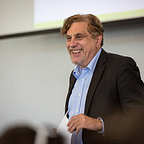It’s Been Happening Everywhere: How Do We Help Students Feel Safe in School Again?
Another school shooting and no end in sight. Another brutal, senseless act, lacking human compassion. It’s hard to comprehend when you consider what goes into raising just one life, how many circles of attachment and commitment surround that life. With one finger on one trigger, in one second, it’s all over. People will tell us again that guns are not the problem, in fact, many will argue that more guns will make us all safer. Others, including former education secretary Arne Duncan, have called for a complete school boycott until stricter gun laws are in place.
Even if the number of students killed in school shootings is extremely small when compared to the 50 million students attending public elementary and secondary schools in the U.S., no child should be worried about getting shot at school. But a recent survey found that the majority of teens (57 percent) worry it will happen to them. When asked by a reporter for a reaction, one Santa Fe High School student in Texas echoed the feelings of traumatized students throughout the country when she said, “It’s been happening everywhere. I’ve always kind of felt like eventually it was going to happen here too.”
My last blog on the shooting at Marjory Stoneman Douglas High School in Florida had very little to do with guns and yet the comments were all from gun advocates. In that piece, I wrote about prevention and intervention and how to build early detection systems. Now we need to sharpen that argument and make it even more urgent. While dealing with the most important issue, the availability of guns for young people whose brains can be prone to impulsivity, grandiosity, narcissism, and attention-seeking, we must also address and repair our relationship with our youth.
If we want to have any chance of stopping this cycle of violence and trauma, we have to be ready to listen to what our students tell us and have systems in place to act.
It’s easy to point to red flags after the fact: the “Unknown Student” slowly navigates the school hallways, often experiencing years of social isolation, detached from the community both in and outside school, and sinking deeper into an inner life of violence, rage, and fantasies of revenge. But retrospective understanding is too little too late for the children lost to this violence. The FBI’s The School Shooter: A Threat Assessment Perspective, recommends that schools undertake an assessment after a threat has been made in four areas: personality traits and behavior, family dynamics, school dynamics, and social dynamics. In all four areas the recurring theme is a lack of connection to others. While a disengagement from peer and family relationships may be a key warning sign of impending violence, the FBI found that many students who go on to commit violence tell someone by either intentionally or unintentionally revealing clues to feelings, thoughts, fantasies and attitudes that may signal an impending violent act to others.
If we want to have any chance of stopping this cycle of violence and trauma, we have to be ready to listen to what our students tell us and have systems in place to act. I propose a radical investment in “knowing every child.” Let’s have every teacher meeting be about: Do we know what is going on? If not, who has the best chance to reach out and reach in? No discussion about academics, especially academic failure, should leave out what the underlying personal causes might be. What I am suggesting is a culture of listening. We should have opening and closing circles so students can share how they feel and what they are thinking about and have trusted adults to talk to when they need support. We need to learn from the excellent bullying research that has gone from a focus on bullies and victims to that of the bystanders. If we take responsibility for each other, isolation will be on the decline and resentment will also decrease.
Of course, serious mental illness can be at play as well. But even that gets worse by doing nothing for so long, either in a child’s school career or over the course of a school year. If there is a concern, we need to act on it. There have been several school shootings stopped by students who spoke up and got help from teachers when their peers issued threats. Parents can be allies or can be in denial. But either way, we need to bring them into the “knowing every child” idea. They often don’t know what is happening and what to do, especially in the trying adolescent years.
This all might sound soft, but it hardly is. Just think about the importance of attachment for well-being in a young child, it is the foundation of all that comes. And we have learned from very strong and longitudinal research that attachment is not over in infancy. Let’s create a coalition of schools and afterschool programs so children are not left unattended for years on the pathway to hate, madness, and murder. We must fight the isolation and internal devastation that comes from being unknown, which comes eerily close to being unwanted.
